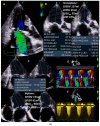Valid and Reproducible Quantitative Assessment of Cardiac Volumes by Echocardiography in Patients with Valvular Heart Diseases-Possible or Wishful Thinking?
- PMID: 37046577
- PMCID: PMC10093440
- DOI: 10.3390/diagnostics13071359
Valid and Reproducible Quantitative Assessment of Cardiac Volumes by Echocardiography in Patients with Valvular Heart Diseases-Possible or Wishful Thinking?
Abstract
The analysis of left ventricular function is predominantly based on left ventricular volume assessment. Especially in valvular heart diseases, the quantitative assessment of total and effective stroke volumes as well as regurgitant volumes is necessary for a quantitative approach to determine regurgitant volumes and regurgitant fraction. In the literature, there is an ongoing discussion about differences between cardiac volumes estimated by echocardiography and cardiac magnetic resonance tomography. This viewpoint focuses on the feasibility to assess comparable cardiac volumes with both modalities. The former underestimation of cardiac volumes determined by 2D and 3D echocardiography is presumably explained by methodological and technical limitations. Thus, this viewpoint aims to stimulate an urgent and critical rethinking of the echocardiographic assessment of patients with valvular heart diseases, especially valvular regurgitations, because the actual integrative approach might be too error prone to be continued in this form. It should be replaced or supplemented by a definitive quantitative approach. Valid quantitative assessment by echocardiography is feasible once echocardiography and data analysis are performed with methodological and technical considerations in mind. Unfortunately, implementation of this approach cannot generally be considered for real-world conditions.
Keywords: cardiac magnetic resonance tomography; echocardiography; left ventricular volume; mitral regurgitation.
Conflict of interest statement
The authors declare no conflict of interest.
Figures






Similar articles
-
[Functional Diagnostics by Rational Echocardiography].Dtsch Med Wochenschr. 2022 Apr;147(9):518-527. doi: 10.1055/a-1554-8329. Epub 2022 Apr 25. Dtsch Med Wochenschr. 2022. PMID: 35468633 German.
-
Evaluation of cardiac valvular regurgitant lesions by cardiac MRI sequences: comparison of a four-valve semi-quantitative versus quantitative approach.J Heart Valve Dis. 2013 Jul;22(4):491-9. J Heart Valve Dis. 2013. PMID: 24224411
-
Quantitative assessment of primary mitral regurgitation using left ventricular volumes: a three-dimensional transthoracic echocardiographic pilot study.Eur Heart J Cardiovasc Imaging. 2014 Oct;15(10):1133-9. doi: 10.1093/ehjci/jeu091. Epub 2014 May 22. Eur Heart J Cardiovasc Imaging. 2014. PMID: 24855214
-
European Association of Cardiovascular Imaging/Cardiovascular Imaging Department of the Brazilian Society of Cardiology recommendations for the use of cardiac imaging to assess and follow patients after heart transplantation.Eur Heart J Cardiovasc Imaging. 2015 Sep;16(9):919-48. doi: 10.1093/ehjci/jev139. Epub 2015 Jul 2. Eur Heart J Cardiovasc Imaging. 2015. PMID: 26139361 Review.
-
Valvular regurgitation: does cardiovascular magnetic resonance provide additional information compared to echocardiography?Minerva Cardioangiol. 2009 Aug;57(4):521-35. Minerva Cardioangiol. 2009. PMID: 19763073 Review.
Cited by
-
Contrast Echocardiography in Heart Failure: Update 2023.Curr Heart Fail Rep. 2024 Apr;21(2):63-72. doi: 10.1007/s11897-024-00647-z. Epub 2024 Feb 2. Curr Heart Fail Rep. 2024. PMID: 38305851 Review.
References
-
- Vahanian A., Beyersdorf F., Praz F., Milojevic M., Baldus S., Bauersachs J., Capodanno D., Conradi L., De Bonis M., De Paulis R., et al. 2021 ESC/EACTS Guidelines for the Management of Valvular Heart Disease: Developed by the Task Force for the Management of Valvular Heart Disease of the European Society of Cardiology (ESC) and the European Association for Cardio-Thoracic Surgery (EACTS) Rev. Española Cardiol. (Engl. Ed.) 2022;75:524. doi: 10.1016/j.rec.2022.05.006. - DOI - PubMed
-
- Lancellotti P., Tribouilloy C., Hagendorff A., Popescu B.A., Edvardsen T., Pierard L.A., Badano L., Zamorano J.L., On behalf of the Scientific Document Committee of the European Association of Cardiovascular Imaging Recommendations for the Echocardiographic Assessment of Native Valvular Regurgitation: An Executive Summary from the European Association of Cardiovascular Imaging. Eur. Heart J. Cardiovasc. Imaging. 2013;14:611–644. doi: 10.1093/ehjci/jet105. - DOI - PubMed
-
- Lang R.M., Badano L.P., Mor-Avi V., Afilalo J., Armstrong A., Ernande L., Flachskampf F.A., Foster E., Goldstein S.A., Kuznetsova T., et al. Recommendations for Cardiac Chamber Quantification by Echocardiography in Adults: An Update from the American Society of Echocardiography and the European Association of Cardiovascular Imaging. Eur. Heart J. Cardiovasc. Imaging. 2015;16:233–271. doi: 10.1093/ehjci/jev014. - DOI - PubMed
LinkOut - more resources
Full Text Sources

